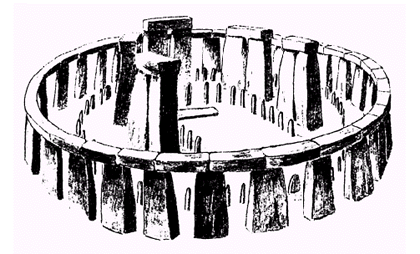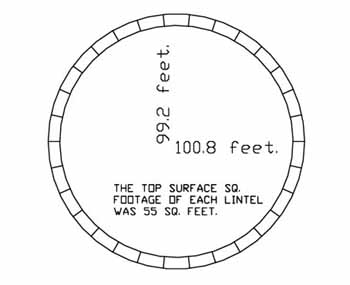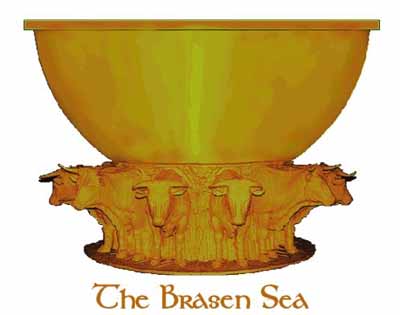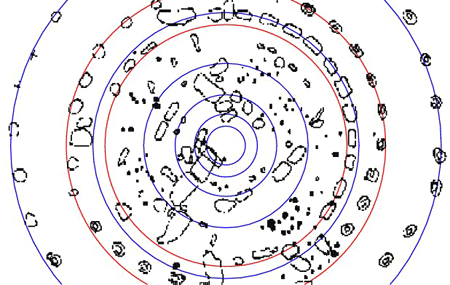THE SARSEN CIRCLE.

Figure 6: In the minds of many people this central region of Stonehenge constitutes the totality of the monument, albeit considerably more dilapidated than the pristine condition shown. The outer Sarsen Circle, circumnavigating and containing the Higher Trilithon Horseshoe configuration further in, is a direct PHI reduction on the "Y" Holes Circle. We have, therefore, gone from Aubrey Circle ÷ PHI = "Y" Holes ÷ PHI = the Sarsen Circle outer rim. This means the "perfect" circle coding of the Sarsen Circle was 110.0062233 feet (110 feet). The outer rim circumference was coded to read 345.6 feet (172.8 feet X 2 or 115.2 X 3).
There is duplicate usage of diameter numbers based upon 132, between the Sarsen Circle outer rim and "Z" Holes. Whereas the actual diameter of "Z" Holes was literally 132 feet, the diameter of the Sarsen Circle, outer rim to outer rim, was 1320 inches. This infers the use of the selfsame geodetic numbers, but ratioed to a different value.
While this "perfect" circle concept was relevant to the extraction of certain codes, the Sarsen Circle was deliberately built slightly elliptical...let's endeavour to find out why.
Much of the coding built into the Sarsen Circle standing megaliths and lintel capstones relates to the "ring of the Earth" and the primary ways in which the Earth's size was measured and grid referenced. Let's review the 2 main systems found upon the Giza Plateau pyramids and incorporated into Stonehenge's Sarsen Circle:
SEXAGESIMAL METHOD:
The Great Pyramid's base
perimeter value (3024 feet) was representative of ½ a minute of arc under
this system. The Earth's circumference value was found by multiplying 3024
X 43200. Remember that the radius of the Sun is 432000 miles and that the
Royal Cubit length for one side of the Pyramid is 432.
The Earth, therefore, was considered to be 130636800 feet or 24,741.81818
miles. This sexagesimal rendition could be broken down into degrees, minutes
and seconds of arc.
Therefore, 1 degree of
arc (1/360th of the circle of the Earth) was 362880 feet. Note that the "inch
value" for the Great Pyramid's perimeter was 36288" (3024 feet X 12).
1 minute of arc (1/60th of a degree of the circle of the Earth) was 6048 feet.
Note that this is twice the perimeter value of the Great Pyramid (3024 feet).
The degree increment of 1 second of arc was 100.8 feet.
Note that the Sarsen Circle, outer diameter was 110 feet and that the lintels were 5 feet wide. This means that the coded circle that best represented the diameter of the inner Sarsen Circle was 100 feet. However, the ancient astronomer/ surveyors wished to incorporate an additional code across the inner diameter and so made the Sarsen ring very slightly elliptical.
A cross measure of the Sarsen Circle's inner diameter will show that one section achieves a width of 100.8 feet and this was done deliberately to code 1 second of arc for the ring of the Earth.
Under this sexagesimal
method of calibrating the size of the Earth, the increment that represented
the circumference of the Sarsen Circle's outer rim was 345.6 feet. This means
that the outer rim value was 1/378000th of the circle of the Earth. Remember
that ½ the base value for one side of the Great Pyramid was 378 feet and that
a circle of 378 feet diameter best represents the containment circle into
which Stonehenge would fit.
The greater Stonehenge site was built slightly elliptical, as evidenced by
the overall shape of the embankment and trench, but a circle of 378 feet diameter
perfectly encompasses the site at 45 degrees azimuth to 225 degrees azimuth,
apart from the Avenue extension.

Figure 7: A topographical view of the slightly elliptical, Sarsen Circle lintel stone ring at Stonehenge, which incorporates many codes dedicated to the size of the Earth.
The Sarsen Circle is loaded with very profound codes which, on the top lintel surface, deal, primarily, with the size of the Earth and three geodetic systems used for navigation and land-mapping. These codes are:
(1). The outer ring was based upon two PHI reductions of the Aubrey Circle and was coded to a circumference of 345.6 feet (172.8 X 2). This was 1/378000th of the size of the Earth under the sexagesimal system, which broke the circle of the Earth into degrees, minutes and seconds of arc.
(2). The slight elliptical shaping of the Sarsen Circle was to code 100.8* feet of diameter between two inner sides of opposing lintels. As stated, this was to code one second of arc for the Earth under the sexagesimal geodetic system.
(3). Several codes were incorporated into various ways of reading the inner diameter of the Sarsen circle. In a perfect circle sense it was read as 100 feet in diameter. This was to code PI in feet, with an inner rim reading of 314.16 feet.
(4). In a second reading, the PI figure was slightly modified from 3.1416 feet to 315 feet (3780 inches). This was to break the 30 lintel sections into increments of 126 inches each (10.5 feet), which was the ancient "reed" measurement.
(5). The "315"
method used on the inner rim is an exact, enlarged ratio duplication of the
calibration method used on the Brasen Sea calculator of the Temple of Solomon.
That device had an outer rim value of 30 Royal Cubits (of 21 inches each)
culminating in an inch value of 630" (315 X 2...5 reeds). It was used for
Sabbatical calendar determinations, with the 300 "knops under the brim" acting
as calculation aids.
The use of 315 feet on the inner Sarsen rim at Stonehenge introduced a similar
septimal calibration for Sabbatical calendar work.
It also meant that every
12 degrees of arc on the Sarsen Circle inner rim was 1 reed or that every
30 degrees (the length of 1 house of the zodiac) was 2.5 reeds.
Even the 288 feet diameter Aubrey Circle exploited this modification of PI
(3.1416 to 3.15) in one coded reading of its circumference value. The diameter
X 3.15 = 907.2 feet and the length of 1 side of the Great Pyramid was 9072
inches (756 feet). The Aubrey Circle was used, generally, to a calibrated
circumference value of 900 feet or 600 common cubits of 18 inches (900 or
600 parts, depending on the nature of the calculation being done).

Figure 8: The Brasen Sea calculator of the Temple of Solomon, which used the same calibration, at a reduced ratio, as the inner Sarsen Circle. The outer rim of the Brasen Sea was 30 Royal Cubits of 21 inches each, whereas the inner rim of the Sarsen Circle was 30 lintel faces of 1 reed (10.5 feet) each. The Brasen Sea was calibrated to 630 inches of circumference and the Sarsen inner rim to 315 feet (½ of 630 feet). It appears obvious that the Greek Stadia was originally intended to be 630 feet and that the rim of the Brasen Sea was 1/ 12th of a stadia in circumference. Alternatively, the inner rim of the Sarsen Circle was ½ a stadia in circumference.
Another relationship between the Israelite, British and the Greek system occurs in the "foot" value for the Brasen Sea, which was 52.5 feet. Eratosthenes, the Greek mathematician, said that the Greek mile was 8.3333333 stadia's or stadium's (which would be 5250 feet @ 630 feet per stadia…the height of the Great Pyramid to the top of its flat floor (symbolically 453.6 standard feet, but actual height based on 168 Megalithic Yards or 453.049492 feet) ÷ 1.728 feet = 262.5, which is 525 ÷ 2.
Therefore, the outer rim of the Brasen Sea @ 52.5 feet was undoubtedly 1/1000th of a Greek mile. By consequence, each 6-degrees of arc or ½ a reed length of the inner Sarsen Circle at Stonehenge was 5.25 feet. The 5.25 feet increment, originating within the dimensions of the Great Pyramid, was simply one of many lengths that could be pressed into service by fledgling civilisations, intent upon adopting tried and true, ancient systems of metrology.
Evidence on many calibrated
circles, including the Sarsen Circle at Stonehenge, would suggest that the
ancient navigators used a specialised and marginally adjusted expression of
PI for navigation. This was set to 3.141818182 and would always achieve a
perfect, breakdown sexagesimal circumference value in any of the 11 series
linear measurements, including the link.
It is very plausible to consider that mariner/ navigators would have had a
calculation rod of 1.728 feet (20.736 inches) for geodetic, mnemonic reference.
Such a rod would be in direct ratio to the 51840 feet circumference achieved
in a diameter of 1 league...51840 ÷ 1.728 = 30000 or 51840 ÷
20.736 (the inch value rod would nave been 20.736") = 2500.
Some rods have been found in Egypt, which are slightly in excess of 20.7 inches
and it is now time to return to a close analysis of all rods located and the
hieroglyphics displayed above each incremental segment. The 345.6 feet outer
rim of Stonehenge would equate to 1.728 X 200 or 345.6 feet ÷ 20.736
= 16.666666666. Remember, the adjacent in 3,4,5 triangulation is always 1.666666666
less than the hypotenuse. A ratio code, based upon 16.666666666 is used to
describe the inner rim value of the Sarsen Circle (315 feet) as it relates
to the Greek mile identified by Eratosthenes...5250 feet ÷ 315 = 16.666666666
feet.
THE 11 SERIES GEODETIC SYSTEM.
It is possible that the
other cross-measure of the inner Sarsen Circle, the 90 degrees opposed diameter
to the 100.8 feet (second of arc) diameter, was adjusted marginally or coded
to read 99 feet, rather than 99.2 feet. In such a reading that distance would
translate to 1/80th of 7920, the acknowledged diameter of the Earth in miles.
This assumption might be supported by other evidence, which accentuated the
7920 figure or the 11 series geodetic system on many British sites, with yet
others in countries further afield. For example:
(1). An increment of 100.8 feet translates to a circumference of 316.67328 feet. This is reasonably close to 316.8, which is 1/25th of 7920. Arbor Low observatory's outer rim complies with a diameter of 252 feet, which translates very well to a circumference of 792 feet. A number of Scottish sites, assessed by Huber were found to express diameters of 21 feet (252 inches) inferring rim calibrations of 792 inches (see Megalithic Science, by Douglas C. Heggie, chpt. 3).
(2). The ancient increment of the league is one of the lengths, like the reed, which became lost to human memory. It is now thought to have been of Gaulish origin and described as anything from 2.4 to 4.6 statute miles.
The English league is
known to have been about 3 miles. This distance measurement, like the fathom
(which was once 5.5 feet and later elongated to 6 feet), has been subjected
to much tampering and erratic modification in the last 1500 years or so.
Strong evidence coupled with applied logic would suggest that the original
league was 3.125 statute miles (16500 feet) and the largest of the distance
increments in the 11 series geodetic system.
An expression of 16500
shows up in the coded square footage of the Sarsen Circle lintel tops, which
have a value of 55 square feet each. There were 30 such lintels with outer
face lengths of 11.52 feet (1/30th of 345.6 feet) and inner face values of
10.5 feet (1/30th of 315 feet), in conjunction with an average width of 5
feet. It becomes obvious that the ancient architect/ mathematicians wanted
to code each lintel top as 55 square feet. Remember also that the diameter
of the outer rim of the Sarsen Circle was 110 feet (55 X 2).
Because there were 30 such lintels, their combined top surface value was 1650
square feet, which is known to relate to the ancient rod or perch increment
(16.5 feet …3 fathoms of 5.5 feet each).
(3). If the base perimeter of the Great Pyramid was considered to be 3025 feet (11 series), rather than 3024 (6 series…sexagesimal), then many archaic British increments of length would suddenly make sense and relate directly, as a family of measurements, to the size of the Earth. The perimeter value of 3025 feet X 43200 = 130,680,000 feet and If 130,680,000 feet are divided by 792 (the rim value coded into many British sites) the resultant number is 165000 feet. This is demonstrating a consistent recurrence and usage of 1650.
(4). A value of 130,680,000 equates perfectly to 24,750 statute miles of 5280 feet each. It is also 7920 increments of 16500 feet each. The 16500 feet increment equals 3.125 miles and the ancient English league was known to have once been about 3 miles. Logic, coupled with an accompanying string of archaic British measurements, based upon an 11 series of numbers, point conclusively to the original league being 16500 feet.
(5). The circle of the Earth was, therefore: 7920 leagues of 3.125 miles or 16500 feet each; 24,750 miles of 5280 feet each; 198,000 furlongs (furrowlongs) of 660 feet each; 1,980,000 chains of 66 feet each; 7,920,000 rods or perches of 16.5 feet each; 23,760,000 fathoms of 5.5 feet each; 198,000,000 links of 7.92 inches each. Alternatively, the diameter of the Earth is 7920 miles.
(6). Under this system, one degree of arc was 363,000 feet. This is equal to 22 leagues; 68.75 miles; 550 furlongs; 5500 chains; 22000 rods or perches; 66,000 fathoms and 550,000 links.
(7). Under this system, 1 minute of arc was 6050 feet (2 X 3025). This is equal to 110 fathoms.
(8). Under this system, 1 second of arc was 100.83333333 feet or 1210 inches.
(9). Beyond the aforementioned 2 systems was a PHI system that assigned a value of 24,711.79047 miles to the "ring of the Earth" or 48384000 Megalithic Yards. This equated to 134400 MY per degree of arc, 2240 MY per minute of arc or 37.333333333 MY per second of arc (112 MY ÷ 3).
THE CIRCLE ENCASING THE TRILITHON, 792 & THE LUNAR NUTATION CYCLE.

Figure 9: Sitting inward of the Sarsen Circle inner rim (coloured red) is the next PHI reduced circle down from the outer Sarsen Circle. It is here shown coloured blue and is seen to brush the rear monoliths of the Trilithon in its circuit. The Trilithon itself was horseshoe shaped and very elliptical. Its function, within the greater site, will be carefully explained later in the text. This circle is a PHI reduction on the diameter of the outer Sarsen Circle and is 110.0062233 ? PHI = 67.98758871 feet in diameter or, essentially, 25.2 Megalithic Yards wide (25.21118576 MY actual).
The size of this PHI reduced circle divulges a series of important codes, which are:
1. In actual feet of diameter (67.98758871)…it's probable that this was used to remember the 6798.36 days of the lunar nutation cycle (18.613-years).
2. The Megalithic Yard, close proximity value of 25.2 MY diameter would likely have been used to remember 1/12th the base length value of the Great Pyramid @ 252 feet (3024 ? 12). The 252 number is used prolifically in ancient astronomical/ mathematical endeavour and describes, amongst other things, the Moon's mean apogee, which is 252,000 miles (furthest point of orbit from the Earth).
3. The true significance of this diameter relates to the Megalithic Yard circumference that it produces, which is, 25.21118576 MY X 3.1416 = 79.20346119 MY. This is in remembrance of the 7920 leagues (24,750 miles) in the "ring of the Earth" under the "11 series" geodetic system. It would also have been used to remember the 7920-mile diameter of the Earth.
A PHI reduction on this circle produces another, diminished PHI circle of 42.01864294 (42 feet). Logic and sound trigonometric analysis of the Great Pyramids coded possibilities, dictate that this is the same size as one formerly displayed on the pyramid's altar. Multiplying this value by PI produces a circumference of 132.0057687 feet (132 feet once again...a major geodetic increment).
A PHI reduction of this circle produces one of 25.96895092 feet and this value rendered in Megalithic Yards and multiplied by PI achieves a value of, essentially, 30.25 Megalithic Yards of circuit. The 30.25 MY is in remembrance of the 3025 feet perimeter value of the Great Pyramid under its "11 series" assignment, representing ½ a minute of arc for the ring of the Earth.
These circles of the
Stonehenge site, so far described are, by no means, the totality of the circles
used at Stonehenge. There were several others, including those that designated
the extremity limits of the circumnavigating ditch or the crown of the embankment.
These "other coded circles" will be identified and explained as we proceed.
If the reader has been conscientious and has checked the numbers found, thus
far at Stonehenge, against earlier numerical codes extractible from the pyramids
of the Giza Plateau, he or she will see a consistent reoccurrence of the selfsame
values. It is, in this author's view, absolutely beyond question that those
who geometrically laid out Stonehenge did so according to Great Pyramid, Khafre
and Menkaure codes. The measurement increments used at Stonehenge are exactly
the same as those used on the Giza Plateau to build the magnificent edifices
of ancient Egypt.